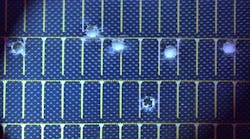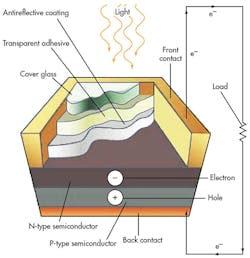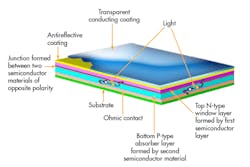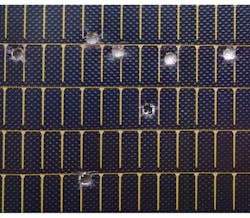What’s the Difference Between Solar Panels?
This file type includes high resolution graphics and schematics when applicable.
Solar panels or photovoltaics (PVs) are not new in terms of the technology. However, manufacturing processes, cost reduction, and new research has some engineers thinking that photovoltaics will rival traditional power sources, such as coal. How important is Big Solar going to be? And what are the differences between the different types of photovoltaics?
Many companies have gone out of business in this field. As popularity increases, though, it could mean a big payoff to the company that harnesses this technology and applies it in the right way.
“Solar workers have outnumbered coal workers in the U.S. for some time, but now their ranks have swollen to surpass even the oil and gas industry,” notes Joshua Pearce, Associate Professor of Material Science and Engineering at Michigan Technology . “It is not uncommon to have solar power be the less expensive option—lower-level cost of electricity—for both homeowners and businesses. This is driving a positive feedback loop, where additional growth is expected. The cumulative global market for solar PV is expected to triple by 2020 to almost 700 gigawatts (GW), with annual demand eclipsing 100 GW in 2019.”
In the U.S., the Energy Department’s National Renewable Energy Laboratory (NREL) published the falling prices of PVs. In the first quarter of 2016, it showed costs declining 6%, 4%, and 20% in the residential, commercial, and utility-scale sectors, respectively, compared to the last quarter of 2015. The NREL tracked the hard costs (structural and electrical components) and the soft costs (land acquisition, sales tax, overhead, and labor) from 2009 to 2016 through its SunShot initiative. (The SunShot initiative is a national collaboration to drive solar energy to be fully cost-competitive with traditional energy sources by the end of the decade.) NREL and SunShot have shown a trend of significant cost reduction over the years. Though cost reduction is slowing, it hasn’t stopped.
In just the second quarter of 2016, the U.S. installed 2,051 MW, raising the total capacity of PVs to 31.6 GW. That puts the industry on pace to double this year, according to the Solar Energy Industries Association, or SEIA. “With more than 10 GW of utility PV currently under construction, the second half of this year and the first half of 2017 are on track to continue breaking records for solar capacity additions,” says Cory Honeyman, GTM Research’s associate director of U.S. solar research.
Tesla and SolarCity show off one of four styles that integrate the solar panel directly into a shingle to integrate the roof with the solar panel. This isnât a new idea, but like many things associated with Elon Musk, itâs the first time this technology looked so good.
As if solar weren’t already growing fast enough, Elon Musk, principle shareholder of SolarCity, showed a new version of solar shingles this past October. Just as he did for electric cars with Tesla, it looks like Musk is trying to make solar shingles more accessible to consumers. By bringing down the cost, making installation easier, and—most of all—making solar cells more visually attractive, SolarCity hopes to offer a new way for people to think of alternative energy.
When solar shingles first became commercially available in 2005, they were expensive and unsightly. Many companies have gone out of business in the solar industry—including solar-shingle companies. However, with reducing costs, electric cars becoming more popular, and people like Elon Musk backing PVs, it’s an exciting time for solar technology. With the growth in solar expected to continue, let’s look at the differences in PV technology.
While there is plenty of excitement about new organic cells, it will take some time before they’re commercially available (if they even reach that stage). Until then, the main types of PVs are crystalline-silicon (c-Si) cells and thin-film technology.
Two Flavors of Crystalline Silicon
There are two types of c-Si cells: monocrystalline and polycrystalline. The differences are minimal when considering purchasing one panel over another. This is where finding a provider who sells both types of cells will ensure the best one is selected, assuming that it would potentially make a difference to the application.
A basic image of the layers of a crystalline PV show the light entering, which will essentially dislodge electrons to create a flow of electricity.
Monocrystalline
These cells may also be called first-generation or traditional solar cells. As the name suggests, monocrystalline panels are manufactured from a single crystalline structure. “The silicon rocks are melted at 2500ËF,” explains Amy Beaudet, an application engineer for altE solar company. “Then a seed crystal is lowered into the slush and drawn up while rotating.”
Called the Czochralski method, this process can be more expensive than polycrystalline processes. Efficient processing has helped reduce this price gap, but the monocrystalline process is still more wasteful and often costs a little more than polycrystalline cells. In some older solar cells (say 30 years ago), you can see that the individual cells are actually circular in contrast to the square cells manufactured today. The shape changed because surface area exposed to the sun is important, and the circle obviously leaves voids between cells.
Polycrystalline
Polycrystalline also starts as a silicon rock. The silicon rocks are loaded into a vat or mold and then melted at 2500ËF for about 20 hours. It takes about three days to cool the rock before processing can continue. This produces a square ingot that will generate less waste and cost when manufacturing a panel.
While polycrystalline might be more cost-effective, it tends to be less efficient at converting energy. For example, if the efficiency of a monocrystalline cell is about 2% greater than the polycrystalline cell (say, 17% vs. 15%), the difference is about 10 watts (W) per regular panel—270 W (mono) vs. 260 W (poly). If you needed a 5400-W system, you would need 20 monocrystalline panels and 21 polycrystalline panels. This may require extra labor or electronics to handle the extra panel.
So, if space or the difference of one panel in 20 isn’t a concern, the difference might not matter. The differences are slight. Due to its lower costs, however, polycrystalline is currently the dominant technology in the residential market, according to SolarReviews.com.
Oak Ridge National Laboratory offers a great video on the crystalline-silicon process:
This type of processing has led to research into many new types of organic and chemical compositions, but we will focus on the three main types of thin films.
The layers of thin films can experience problems even with an efficient roll-to-roll process. For instance, tension on the cells during manufacturing may cause deformation, or the different layers might be distributed unevenly or diffuse between each other.
Cadmium telluride (CdTe)
CdTe makes up a large part of the market, as it tends to be more efficient and offer a lower dollar-per-watt ratio than other thin films. CdTe is often processed on glass, which means it is not flexible. This can present manufacturing and installation challenges compared to other thin films. Still, the lower cost might entice someone to select this type over a c-Si.
Copper, indium, gallium, selenide (CIGS)
CIGS faced challenges to manufacture a consistent product, due to difficulties controlling deposition rates when manufacturing. While the technology gets closer to c-Si in efficiency, it isn’t easy to do and tends to make the panels more expensive. In addition, CIGS material is sensitive to moisture. Panels must encapsulate the CIGS material or the PV will stop working.
In 2014, Dow released PowerHouse solar shingles in hopes of changing the consumer’s mind and streamlining production. In fact, Scientific American called the company the biggest name in solar shingles. This past June, though, Dow announced it will cease manufacturing the panels.
Amorphous silicon (a-Si)
Most flexible solar panels available today typically consist of a-Si. While these panels are the lowest in efficiency and more expensive than c-Si, they are relatively easy to manufacture, while being durable and lightweight. Mobility and electronics represent a large market for a-Si panels. Though you might not see these panels on a house, you may buy a tent with built-in lights and/or charging stations. Panels that roll or fold are being put into outdoor equipment, boats, and pockets to keep electronics charged longer while trekking off-grid.
With recent news regarding SolarCity, I assume they may be taking advantage of Tesla's partnership with Panasonic, using Panasonic's heterojunction with intrinsic thin layer technology (HIT). It incorporates two different semiconductor materials—hydrogenated amorphous silicon (a-Si:H) and c-Si—to create the p-n junction diffused homojunction emitter. “This technology works well and offers efficiencies up to 22.3%,” says Dr. Frank Jeffrey, president of PowerFilm. “It’s moderately expensive to produce, but it is a proven technology.”
Overall, thin-film PVs represent a small portion of the market and have been called an immature technology. However, improvements in this technology are expected over the next 10 years. Currently, they are the least efficient and most expensive PVs on the market. But manufacturing costs are falling and expected to dwarf mono and polycrystalline cells. Of course, we’ve heard this before from thin-film manufacturers. Yet the flexible, lightweight solar cell (predominantly a-Si) can be manufactured with roll-to-roll continuous processing, allowing applications to benefit from thin-film technology.
Serving the IIoT
The move to the Industrial Internet of Things (IIoT) has led to more remote sensing and monitoring. In field applications, however, a hardwired power source may not be available. These applications need batteries, capacitors, or PVs to operate.
PVs can extend the time between changing batteries or capacitors, or replace the need for them completely. For indoor applications, remote power is ideal for thin film. “Traditional or crystalline PVs will operate well with direct sunlight, generating electricity from infrared light,” says Dr. Jeffrey. “Thin-film a-Si is able to work well in the visible light spectrum that is used in interior or factory lighting. This makes it a handy solution for indoor IIoT applications, where hardwiring may be costly or difficult.”
For outdoor applications, a remote sensor can simply update when the sun is out—so long as the timing of received data isn’t important and memory is enough to save data between sunny days. Most likely, in these types of applications, a small battery will work with the PV so that data is sent more regularly. Such remote locations might not be ideal for solar, though. For example, indirect light, shadows from trees, telephone poles, etc., will greatly affect the performance of a PV.
For a mono or polycrystalline panel, the cells are wired in series. If part of the panel is shaded, an entire line of cells might stop generating power. Consider it like old Christmas lights—when one bulb blew, the whole line of lights went out. Wiring panels in parallel or additional electronics can prevent the whole grid from going down. However, a single tree or telephone pole might greatly decrease the solar gains.
“In addition, thin-film technology is able to operate in lower light conditions,” notes Jim Kimbrough, President of P3solar. “The ability to harvest electricity on a wider range of wavelength can make thin film produce electricity through non-ideal conditions.”
Most testing conditions or published values are presented in ideal, direct-light conditions. If thin film is better in low light, perhaps another set of values needs to be published for PVs.
With or without a low-light published value, thin film just can’t compare to the output per cost of a crystalline panel (with maybe an exception for CdTe). The main argument for a-Si is indoors and in applications that are concerned about output per pound. “A 30-W silicon panel [c-Si] weighs 7 lbs and a 30-W foldable [CIGS] from P3 solar weighs 0.75 lbs,” says Beaudet. “That's a big difference if you are hiking with it.” This aspect has led some mobile and remote applications, such as outdoor enthusiasts or military personnel, to use thin-film technology.
These remote or mobile applications tend to use smaller thin-film panels, whereas large applications, such as rooftops, will lean toward c-Si technology. However, “it is possible to use thin film on rooftops,” states Kimbrough. “Simple peel and stick applications can be used on a metal roof. Or if there is a non-load-bearing area, the engineer might have to go with the lighter thin-film option.” While such cases are not typical, they may offer a potential solution.
Another difference in PV technology concerns temperature resistance. As the temperature rises, a panel can become less efficient. For example, for every degree Celsius over 25ËC, the efficiency of c-Si, CdTe, CIGS, and a-Si will reduce –0.5%, –0.35%, –0.6%, and –0.2%, respectively. This means on a hot day that pushes past 100ËF, efficiency could decrease by 10%. However, this is linear—every degree under 25ËC will increase efficiency. Ultimately, this factor may balance out in most northern states. But for someone located in, say, a desert, this factor may strengthen the argument for thin film.
Until there’s a drop in thin-film costs, the application has to justify the additional expense. “Small, foldable thin-film panels are more expensive than an equivalent-size silicon panel,” says Beaudet. “Depending on the model, they can be $10 or $15 per watt as opposed to $3 or $6 per watt for a similar silicon panel.”
While Elon Musk’s announcement might make solar sound like a sure thing, remember that the solar industry is highly competitive. Fortune reports that prices in solar will slide by 30% next year due to lower demand in China, and the resulting oversupply of panels worldwide. This past November, First Solar announced that it is forecasting low sales in 2017. The company also said it will be cutting 1,600 jobs, or about 27% of its global workforce. The solar industry can still be a tough market from a business standpoint, despite the amazing benefits achieved with technology.
This file type includes high resolution graphics and schematics when applicable.






